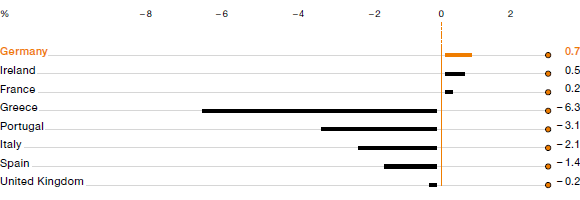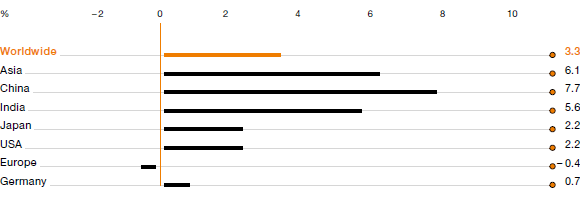The continuing euro crisis has slowed down the world economy, with most EU member states slipping into recession in 2012. Gross domestic product (GDP) declined, especially in the southern European countries of Italy, Spain, Portugal and Greece. Germany escaped this trend, increasing its GDP slightly. The crisis in Europe also slowed economic momentum in other countries around the world. Growth weakened markedly in the fast-growing emerging economies of China, India and Brazil. In the USA, the economy grew moderately during the election year. Stringent austerity measures in many crisis-hit European countries led not only to a substantial drop in the volume of goods and services sold, but also to a marked increase in unemployment and to a decline in disposable personal income. As a result, the downward trend intensified during the course of the year, with leading economic research institutes reducing their growth forecasts further for 2012.
Recession in European Union Member States

Sources: Germany: Federal Statistics Office; Ireland: OECD; France: OECD; Greece: OECD; Portugal: OECD; Italy: IMF; Spain: IMF; United Kingdom: IMF
The International Monetary Fund (IMF) estimates that the world economy grew 3.3 percent in 2012 (2011: 3.8 percent). Originally, the IMF had expected growth of 3.5 percent.
GDP Trends in 2012

Sources – worldwide: IMF; Asia: ADB; China: National Development and Reform Commission, India: ADB; Japan: IMF; USA: IMF; Europe: IMF; Germany: Federal Statistics Office (Dec. 2012)
Asian Growth Weakens
The ongoing euro crisis also dampened economic progress in Asia. Additionally, Asia’s two largest economies – China and India – experienced weak domestic demand. The Asian Development Bank (ADB) expects economic expansion of 6.1 percent (2011: 7.2 percent). Growth in China was also impacted by lower-than-expected exports. Due to the weaker economic trend, the Chinese government passed a stimulus package for infrastructure development and China’s central bank lowered base interest rates. According to the National Development and Reform Commission, China’s economy grew by 7.7 percent (2011: 9.2 percent). India’s economy is struggling not only with lower consumer demand, but also with high inflation and a large budget deficit. This limits the options open to the Indian government for stimulating the economy. India’s GDP climbed by 5.6 percent (2011: 6.5 percent) according to the ADB. In Japan, the economy picked up in 2012, recovering from the earthquake and tsunami catastrophe. According to the IMF, Japan’s GDP grew by 2.2 percent (2011: -0.8 percent).
US Economy Expands Moderately
In 2012, the US economy expanded moderately due to stable domestic demand. Growth, though, was insufficient to noticeably reduce the high unemployment rate. According to the IMF, GDP rose by 2.2 percent (2011: 1.8 percent). The Federal Reserve’s zero-interest rate policy has not yet had the expected effect. In addition, the US needs to tighten its budget, just like Europe’s economies.
Eurozone Still Dominated by Debt Crisis
Europe’s sovereign-debt crisis deepened in 2012, with many crisis-hit economies in recession. Austerity programs, loss of income and high unemployment subdued consumer spending and corporate investments. According to IMF calculations, GDP in eurozone countries dropped by -0.4 percent (2011: 2.0 percent).
German Economy Resilient to Euro Crisis
Germany’s economy proved resilient amid the euro crisis, in contrast to most other European countries. As a result, Germany reinforced its role as Europe’s leading economy, benefiting from both export strength and robust domestic demand. With unemployment remaining low and employment high, tax-revenue increased, further easing the debt burden. Data issued by the German Federal Statistics Office show that GDP increased by 0.7 percent (2011: 3.1 percent).